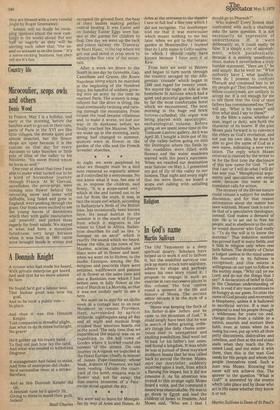Country life
Micocoulier, scops owls and others
Denis Wood
In France, May 1 is a holiday, and early in the morning, before the families start to go out in their cars, parts of Paris in the XVI are like little villages, the streets quiet and almost deserted, but the flower shops are open because it is the custom on that day for every Aucassin to take bunches or little pots of lilies of the valley to his Nicolette, "his sweet friend whom he loves so well."
One year at about that time I was able to make what turned out to be a kind of horseshoe journey through France. At St Gervais, snowflakes, the perce-tierge, were coming into flower behind the retreating snow and some wild daffodils, long faded and gone in England, were pushing through the grass. Our hosts were excited to see the young leaves of dandelions which they with gallic insouciance call Ipissenlit', and picked these eagerly for fresh salads. We stayed in what had been a mountain farmhouse, very large because when it was built in 1861 cattle were brought inside in winter and occupied the ground floor, the heat of their bodies making perfect central heating. It was Easter and on Sunday Easter Eggs were hidden in the garden for children to find. One day we went up the rack and pinion railway, the 'Tramway de Mont Blanc,' to the top where we got out and stood in crisp snow to admire the fine view of the mountain.
After a week we drove to the South in one day by Grenoble, Gap, Castellane and Grasse, the _Route Napoleon along which he marched at the beginning of the Hundred Days, his handful of soldiers growing into an army by the time he reached Paris. The scenery is magnificent but the drive is tiring, the road continually twisting and turning through the mountains. From Grasse the road became villainous and, to make it worse, we lost our way in th darkness before we finally reached Ste Maxime. When we woke up in the morning, early spring had changed to summer, quinces were in flower in the garden of the villa and the French lavender, stoechas.
At night we were perplexed by what we thought must be a bird note repeated so regularly almost as if controlled by a metronome. No one knew what it was, but one Of us, to impress the children, said firmly, "It is a scops-eared owl," which in the end turned out to be not far from the truth. It was, in fact the scops owl which, according to Ballantyne's Birds of the British Isles, has occasionally been known here. Its usual habitat in the summer is in the south of Europe from which it migrates in the winter to Chad in Africa. Ballantyne describes its call as like "a hammer on an anvil" which is exactly the sound which we heard. Below the villa, in the town of Ste Maxime, acacias, laburnums and lilacs were all in flower and later, when we went on to Hyeres, to the Jardin Exotique, among the flamingoes and peacocks there were petunias, wallflowers and pansies all in flower at the same time and also a Banksian rose which I had before seen in fully flower at the end of March in La Mortola, so that it was not unduly early to see it here.
We went on to stay for an idyllic week in a cottage lent to us near Malemort in remote Provence. Here, surrounded by apricot orchards, nightingales sang all day and all night and musical frogs croaked their amorous hearts out in the pond. The only time that we experienced the mistral was on an expedition to the hill town of Gordes where it howled round the corners of the streets. On one journey to Avignon we launched at the Hotel Europe, chiefly in honour of James Pope-Hennessy whose book, Aspects of Provence, we had been reading. Outside the courtyard of the hotel, wistaria was in flower and, not far away, the lilacmauve blossoms of a Paul ownia stood against the sky.
We were sad to leave for Montpellier by way of Arles and Nimes. At
Arles at the entrance to the theatre I saw in full leaf a fine tree which I did not recognise. The doorkeeper told me that it was micocoulier which meant nothing to me but later, when we got to the botanic garden at Montepellier, I learned that its Latin name is Celtis australis which I should really have known because I have seen it at Kew.
From here we went to Beziers and began to turn north through the country savaged by the Albigensian 'crusade' which began in 1209 and raged for twenty years. We stayed the night at Albi at the hostellerie St Antoine which had a quiet and peaceful garden and was by far the most comfortable hotel which we encountered. The next morning in the huge red brick fortress-cathedral, the organ was being played with apocalyptic, eschatological volume. Before going on we spent some time in the Toulouse-Lautrec gallery. As it was April 30, I bought a little pot of lily of the valley before going on into the Dordogne where the fields by the roadsides were filled with flowers and the water meadows starred with the poet's narcissus. When we reached our destination near Salviac on May 1, I presented my pot of lily of the valley to our hostess. That night and every night that we were there, we heard a scops owl calling with unfailing regularity.


































 Previous page
Previous page